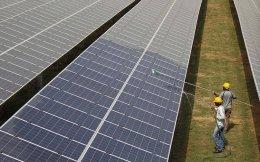The beginning of FY 2011 brought with it the news of another large Private Equity transaction in the Indian Power Sector. Temasek Holdings, the investment arm of the Singapore government, is reported to have announced recently that it would invest around $200 million to buy preference shares in GMR Energy. This announcement comes on the back of a good year for PE investments into the Indian power sector. FY 2010 saw a total of $820 mn being invested in the Indian power sector through 14 deals as against $274 mn through 6 deals in the previous year.
In the largest PE deal in India in the last 2 years and the largest deal in the power sector, a consortium of PE investors comprising Morgan Stanley Infrastructure Partners, Goldman Sachs, Norwest Venture Partners, General Atlantic and Everstone Capital invested approximately $425 million in Asian Genco Pte Ltd. Other large deals in 2010 included the $100 million investment by Bessemer Venture Partners, Citi Ventures and Sequoia in Ind-Barath Power and approximately $75 million investment by IDFC in Green Infra Ltd.
An emerging trend in 2010 were the investments by IDFC into project SPVs or single asset companies – around $45 mn in GMR Kamalganga Energy Ltd and approximately $55 mn in Adhunik Power and Natural Resources.
In terms of deal structures, with the valuation differences between promoter expectations and PE estimations of value expected to continue, transactions may continue to be structured through convertibles instruments rewarding companies for achieving pre-agreed milestones. Temasek’s investment into GMR Energy and IDFC’s investment into Adhunik Power may both (although this news is not confirmed) have some elements of a structured instrument. To limit dilution at this stage, promoters have also been looking to raise mezzanine funds through fixed yield instruments with small equity upsides thrown in as sweeteners.
The continuing demand supply gap promising, some well known cases of projects earning super normal profits and the significant value creation undertaken by some developers that have come out with IPOs, continues to attract new developers into the Indian power sector. These companies believe that the demand supply gap would eventually even out in the long term (there are mixed views regarding what constitutes long term) and hence the opportunity to make profits is now. Consequently, companies are willing to pay premiums to acquire power projects. In the Indian context, since there are really no major projects that are operational (and also available for acquisition at reasonable valuations), most corporate have been looking to acquire projects that are in the “pre-financial closure” stage. Since the government follows an unpredictable process for allotting power projects, companies find acquisition of pre-financial closure projects an attractive proposition since it may save them upto 1-2 years of pre-development time.
However, with the perceived availability of capital from PE and IPO markets, a large number of companies are looking to develop power projects on their own rather than exiting from such projects. Hence, the opportunities for acquisitions have been few and far between.
Among the large M&A deals in the sector in 2009 were IDFC’s acquisition of BP Energy’s 100 MW wind energy business through its subsidiary Green Infra, CESC acquisition of Dhariwal Infrastructure Ltd which is setting up a 600-MW thermal power station at Chandrapur in Maharashtra and Agri Gold Projects acquisition of 18 MW of biomass projects from Lanco Group (Rithwik Energy Systems Limited - 6 MW and Clarion Power Corporation – 12 MW).
The Huge Valuation Differentials : Strategic Investor, PE & IPO
The sector outlook would be greatly affected by the ability of the project developers to raise equity for their power projects, which by their very nature are highly capital intensive. Such funding ability in turn is impacted at present by the valuation dynamics that are prevalent in the equity markets today.
An interesting trend in the Indian context is the valuation differential (viewed in the very simplistic measure of value in Rs. Crs per MW) in the three major investment markets for power projects namely the strategic investor market, the PE market and the IPO market.
Based on the deals that have occurred till date, it appears that strategic investors while acquiring thermal projects with coal linkage are offering valuations ranging from anywhere between Rs. 20 lacs to 60 lacs per MW (no known deals have taken place for coal block related projects but the seller ask for such projects has ranged from around Rs. 100 lacs to 150 lacs per MW). These projects are typically at a stage where the fuel is tied up by way of coal linkage and other aspects like land acquisition, environment clearance and water linkage are in a very preliminary stage.
Hence, financial closure for such projects is at least 1 year away (assuming the buyer in turn has equity funds available with itself). The strategic investor market entails acquisition of project SPV’s and there is really no major instance of any strategic investor buying out a Holding company with a portfolio of power projects. Further, the strategic investor market is dominated by Indian companies and there are hardly any foreign utilities that are active in this market at present (although this trend may change in future when a large number of projects enter the post financial closure stage).
In the IPO market, the market is mostly for raising of new equity (amounting to minority equity stakes) in power holding companies – there is really no major single asset company that has got listed as yet. The IPO market is available for very few (and large) developers and seems to be operating without an even flow of IPO’s. Further, it seems that the IPO markets are flexible when it comes to the extent of development stage of the power projects constituting such power holdco’s with market intermediaries justifying (and some investors accepting) valuations that are based on P/BV or P/E multiples that may seem high today but which are projected to become reasonable if all the projects proposed become operational within the stated timelines. The trend of large IPO’s (at good valuations) based on the promise of a future capacity is a key feature of the power sector IPO’s that is not really seen in other sectors.
For instance, if a cement producer projected that its existing 1 million tonne cement capacity would increase to 20 million tonne by 2015, no investor may believe them but in case the same cement producer projected that their 100 MW captive power capacity would be hived-off and such capacity would then be increased to 5000 MW by 2015, there might just be some investors who may be willing to provide attractive valuations for such future power capacity promise.
Another feature of the IPO markets seems to be that the IPO investors do not insist that the companies raise the full capital needed for commissioning the entire portfolio of projects for which a valuation is being sought implying that IPO investors are comfortable with the idea of lack of full funding and possibility of future dilutions through additional rounds of IPO. With the above major features, the IPO markets are offering valuations ranging from around Rs. 2 crs./MW to 5 crs./MW (depending on which projects are considered for this valuation) for the IPO’s that have been listed. An important development in the IPO market would be the outcome of the Avantha Power IPO (which is the first major power IPO that is likely to hit the market in the near future) that constitutes some operational capacity and a larger capacity that is under various stages of construction/development.
In the PE market, the market is mostly for acquisition of minority equity stakes in power holding companies with a few investors being keen to acquire stakes in individual project SPVs. PE investors analyze power holdcos on issues such as full equity funding, merchant power rates, demand and supply dynamics, execution timelines etc. The preference of the PE investors seems to be to enter into structured transactions wherein limited valuation is provided upfront and the balance valuation is provided in the form of upside sharing structures. The initial valuations offered by PEs may be around (or in some cases even at a discount to) the valuation proposed by strategic investors for acquisition of projects while through upside sharing structures, such valuations could improve significantly. However, despite the detailed scrutiny and the preference for back ended valuations, PE investors are an important source of equity financing for developers whose project are not large enough to be eligible for the IPO market.
With India expected to continue as a power deficient country at least in the short to medium term, the interest among investors in the Indian power sector is expected to continue and is likely to intensify going forward. The most interesting aspects of the market going forward would be (a) to see if there is any valuation convergence (and the direction of such convergence) amongst the strategic investor market, the PE market and the IPO market, (b) the timeline by which the demand supply dynamics correct and the power prices decline (and the extent of such correction and decline), (c) the number of developers who are able to execute (along with the timelines thereof) the projects proposed in their power portfolio’s and (d) the kind of returns that investors actually make in this market.
Kuljit Singh is a Partner and Head of Transaction Advisory Services for the Infrastructure Group at Ernst & Young Pvt. Limited. The views expressed are personal and are not the views of Ernst & Young.





